This post may contain affiliate links. Please read our disclosure policy.
Your complete guide to Southern Collard Greens, covering everything you need to know to make this easy Southern classic. From selecting and prepping fresh greens to simmering them low and slow in a smoky, savory pot likker, this recipe breaks down each simple step so you can confidently serve authentic, flavorful collards on your dinner table every time.
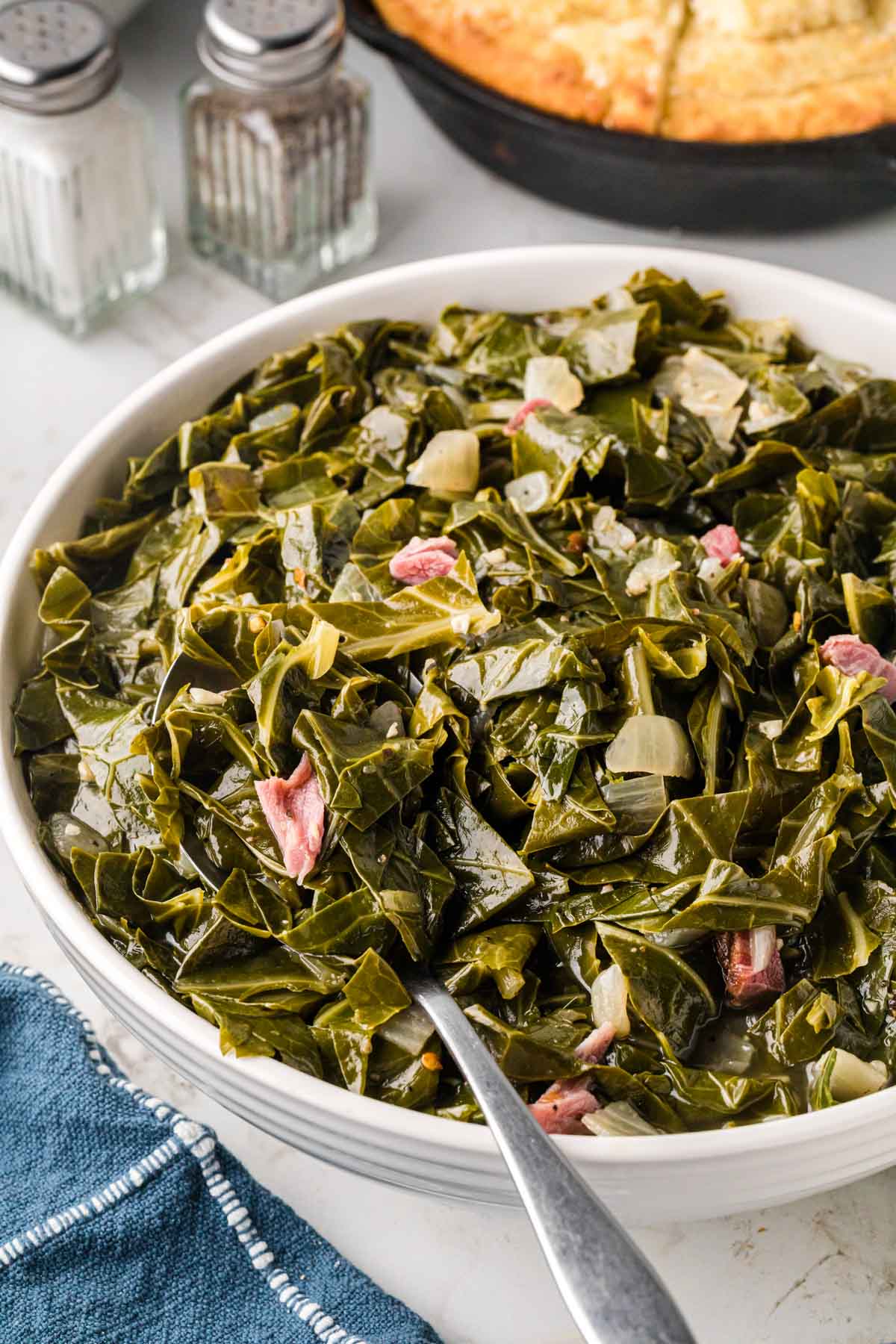
My Go-To Southern Collard Greens Recipe
Collard greens are more than just a dish; they’re a piece of my Southern heritage that’s been passed down through generations. Growing up, I remember sitting at my grandma’s dining table, the smell of rich, smoky greens simmering on the stove and cornbread crisping in the skillet. She never wrote her recipes down, and this is one of the reasons I actually started blogging was to record my recipes for family and friends.
Her love for cooking and feeding her family was something I soaked up and carried with me. Now, making a pot of these greens feels like a nod to those moments! And while she’d spend time prepping everything from scratch, I’m all for using prewashed and precut greens when life gets busy—because it’s about the taste and sharing the experience, not the stress.
This recipe captures everything I love about Southern collard greens: simple ingredients, deep flavors, and a cooking process that’s easy enough for any home cook. From carefully choosing fresh greens (or saving time with the prepped option) to letting them simmer gently in a rich, smoky pot likker, each step is designed to honor tradition while making things simple for the homecook.
Nikki’s Recipe Rundown
- Taste: Smoky, savory, and just the right hint of seasoning—true Southern comfort in every bite.
- Texture: Tender greens that still hold a little bite, soaked in rich pot likker for extra flavor.
- Ease: Simple to follow and easy enough for any home cook, even on a busy day.
- Pros: Uses basic ingredients, packed with flavor, and adaptable to what you have on hand.
- Considerations: Takes some time to simmer, so plan ahead to let those flavors develop.
- Recipe Repeatability: Absolutely—this is a staple in our monthly meal rotation! Perfect for a traditional New Year’s Day dinner, a Sunday supper, or whenever you’re craving comforting Southern food.
Best Meat For Collard Greens
For my recipe, I use pork: either a leftover ham bone, ham shank, or a ham hock. But if you don’t have those on hand or want to try a different taste, here are the best meat choices for collard greens:
- Ham Hock or Shank: These classic options provide a deep, rich, smoky flavor. The meat becomes tender and infuses the greens with savory goodness.
- Ham Bone: Perfect for using up leftover ham bones with bits of meat, adding both flavor and texture to the dish.
- Diced Ham: An easy option that adds a mild, smoky flavor without the need for long cooking. It blends seamlessly into the greens and works well if you’re short on time but still want that classic taste.
- Bacon: Delivers a quick, smoky flavor and pairs well with collards for a faster-cooking option.
- Smoked Turkey: A lighter alternative that still brings a smoky touch, great for those who prefer to avoid pork.
How to Clean Collard Greens
Collard greens often come with dirt, grit, and sometimes little bugs, so thoroughly washing them is a must!
Fill Sink with Water: Wash your sink to be sure it is clean, then fill it with lukewarm water.
Add Vinegar: Add 3 tablespoons vinegar to help loosen any grit.
Add Greens and Stir: Place the collard leaves in the sink, use your hands to scrub the greens, stir them around, and watch as the dirt settles at the bottom.
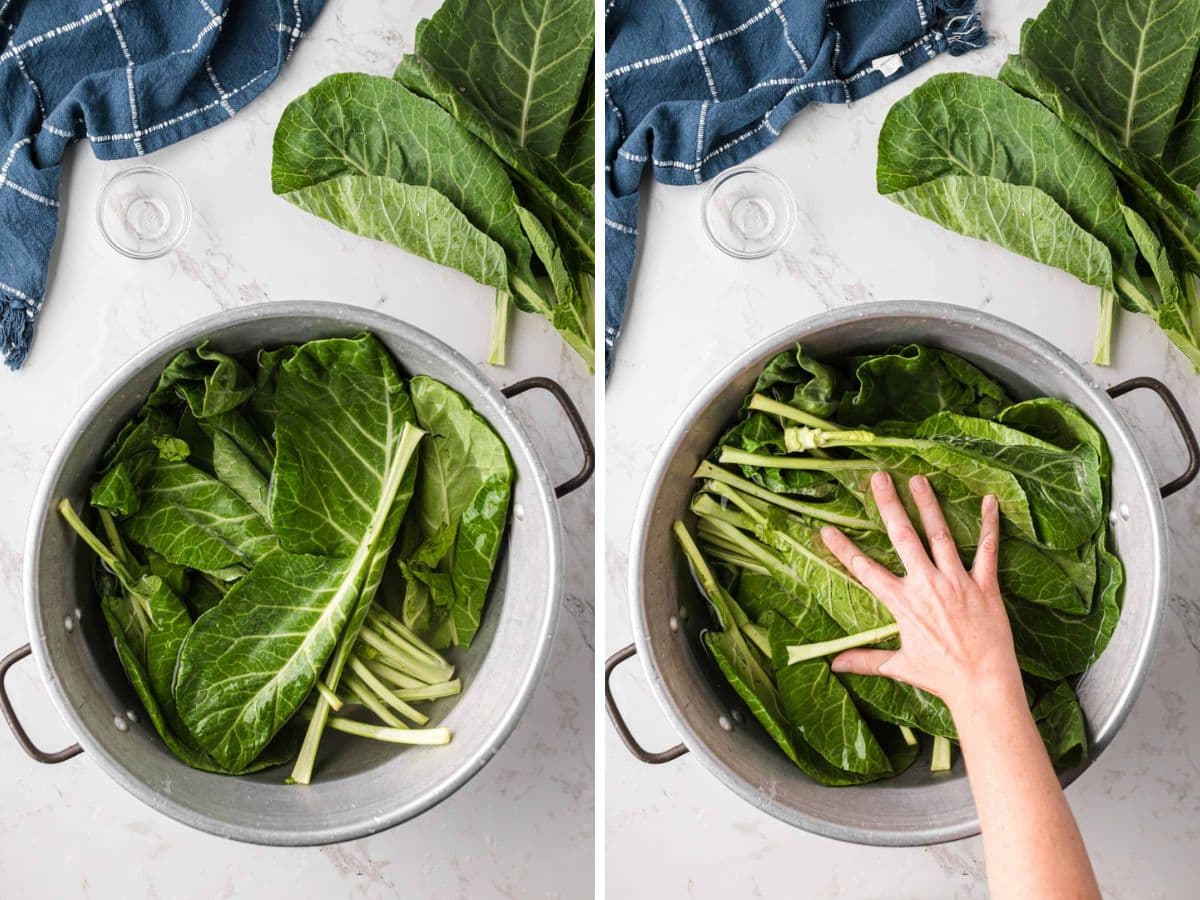
Soak and Drain: Let the greens soak for about 15 minutes, then drain the water.
Repeat: Repeat this process at least 2-3 times or until the water runs clear and is free of any dirt.

How to Prep and Cut Collards
Remove the Stems (De-stemming the Greens)
- By Hand: Hold the stem with one hand and use your other hand to pull the leaf away, removing the stem in one smooth motion.
- Using a Knife: Use a paring knife to carefully slice the stem out of the center of the leaf.
We usually take the stems out for a more tender bite, but if you like them, feel free to leave them in and skip this step—your choice! If you are going to keep the stems, I recommend cutting them down to small pieces.

Cutting Collards Greens
- Roll Collard Leaves: Take a handful of cleaned collard leaves and roll them tightly, like a cigar.
- Slice: Use a sharp knife to slice lengthwise into strips about 1/2 to 1 inch thick.
- Tear Option: If you prefer, tear the leaves into pieces by hand instead (just like my granny used to do).
- Adjust Size: Keep in mind that smaller strips will cook faster, so cut or tear them based on your cooking time preference.
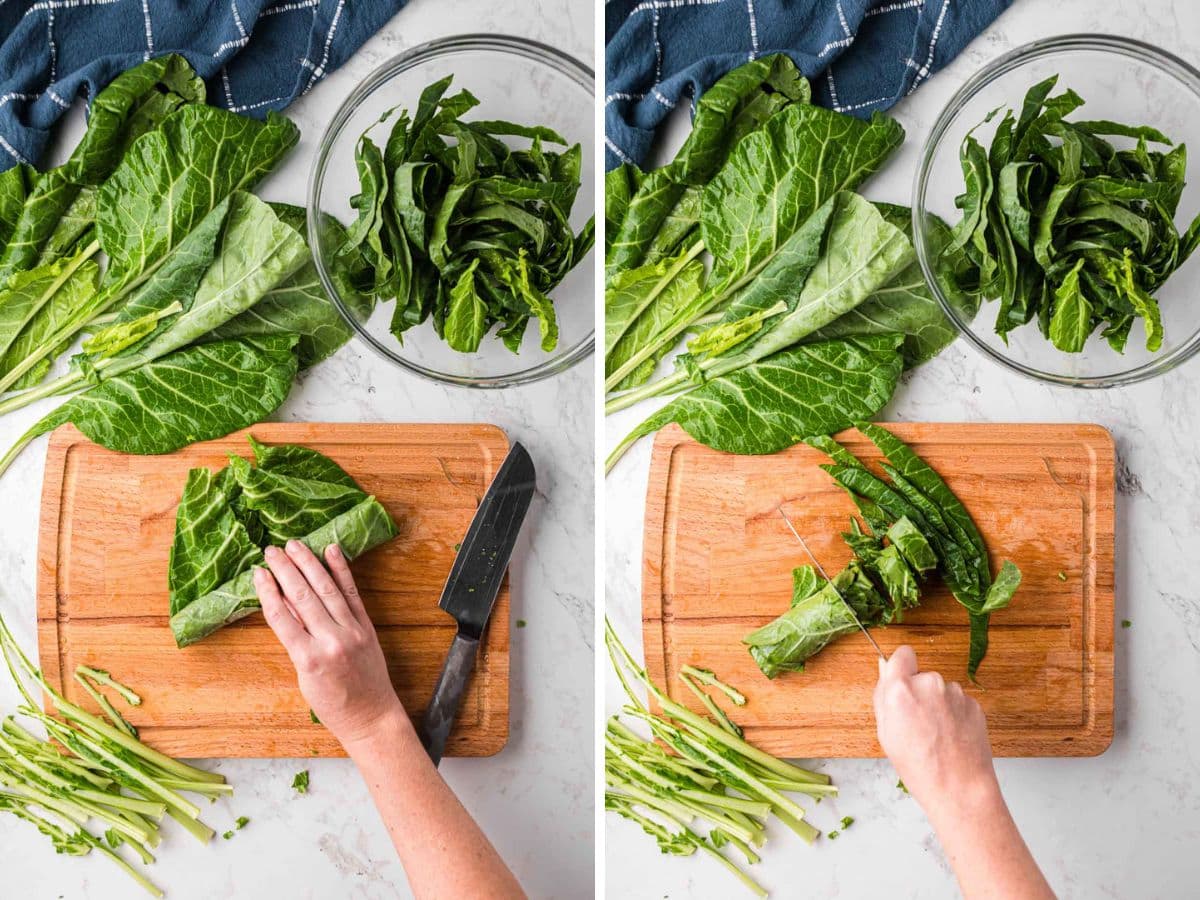
How to Make Collard Greens Southern Style
Step 1. Heat up a Dutch oven or large pot over medium-high heat and drizzle in some oil. Add the diced onion and sauté for a couple of minutes until it turns translucent and fills your kitchen with that irresistible aroma. Next, toss in the minced garlic and let it cook for about a minute until it’s fragrant.
If you’re using bacon instead of ham, start by cooking the bacon first until it reaches your preferred doneness. Remove the bacon from the pot, and if you’d like, dice it into bite-sized pieces to scatter throughout the greens or leave it whole to remove later. Use the bacon grease for sautéing the onion and garlic instead of oil—it adds an extra layer of smoky flavor.
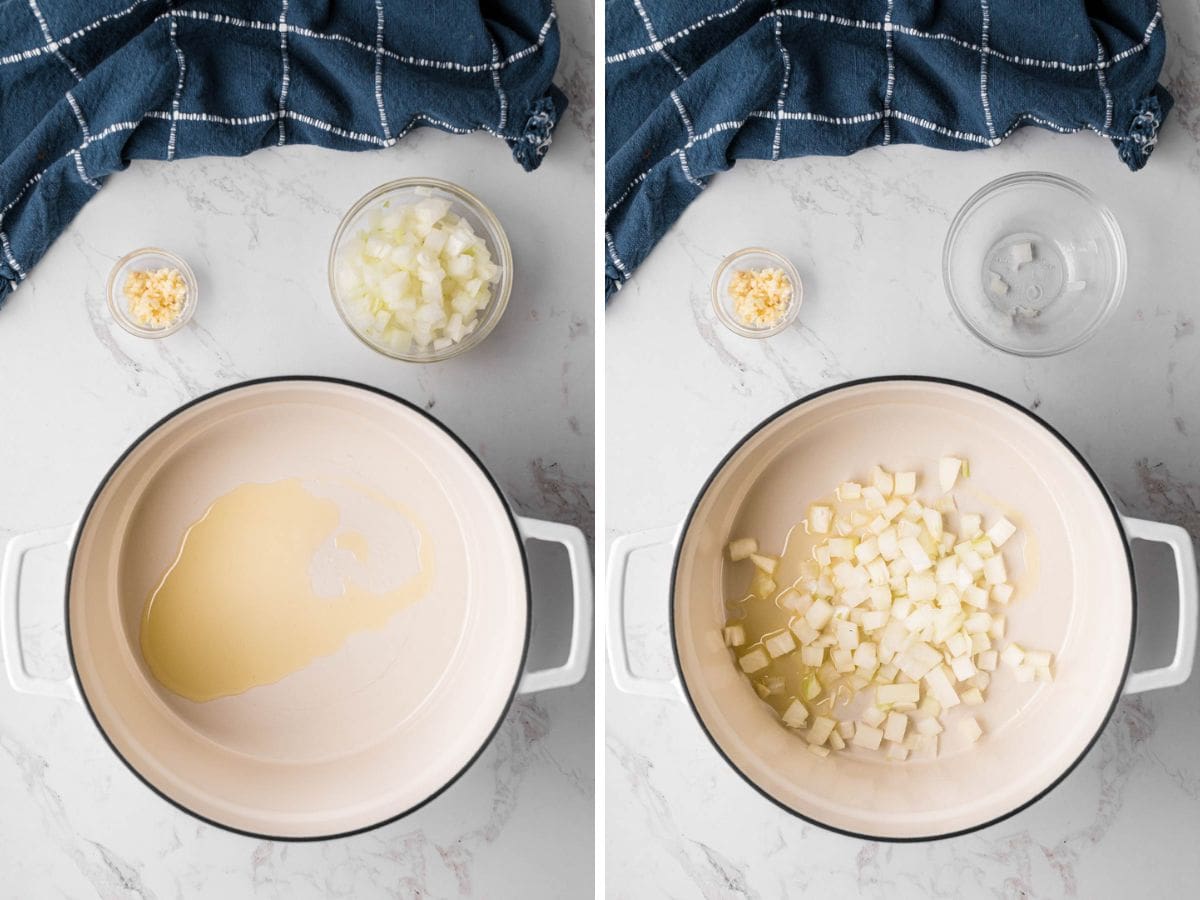
Step 2. Once the onion and garlic are ready, mix in the spices (salt, black pepper, a pinch of sugar, and some red pepper flakes if you’re craving a touch of heat).
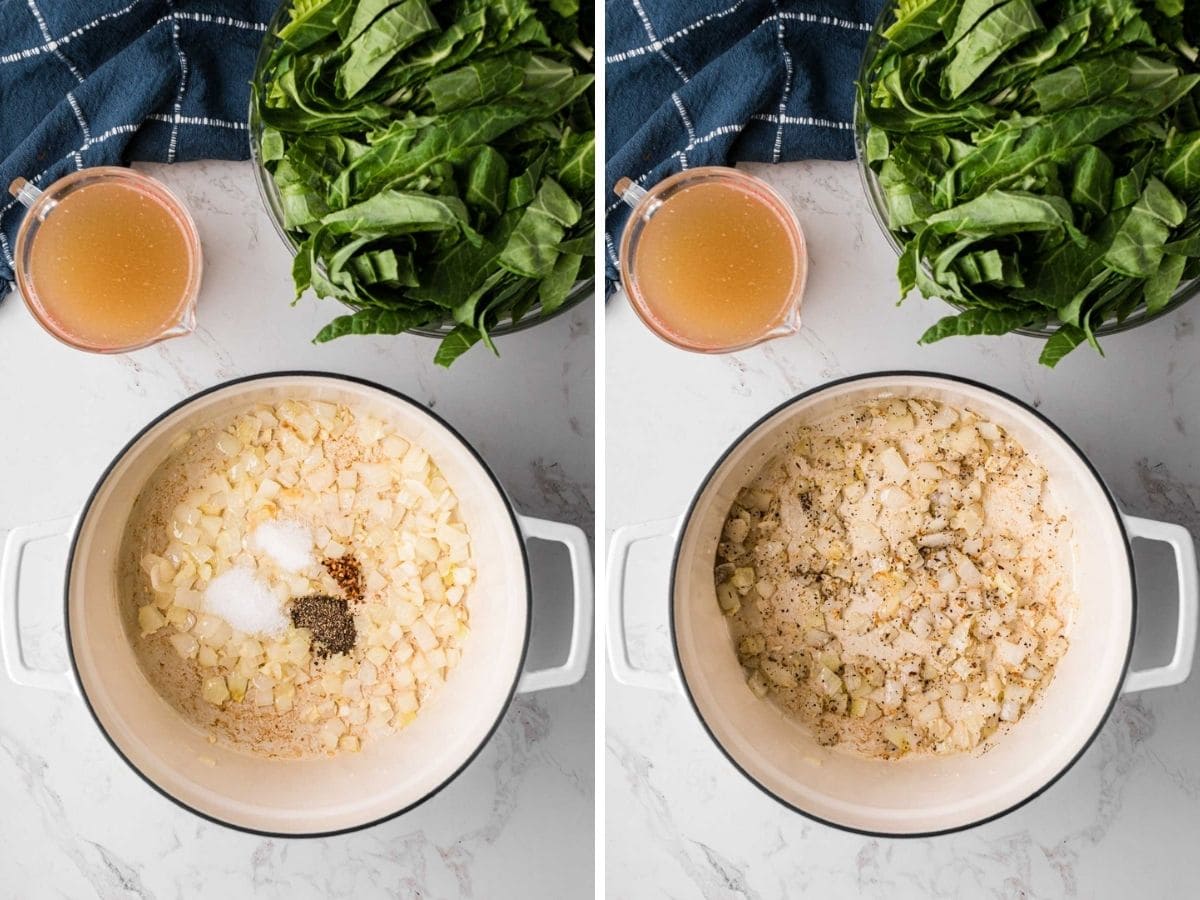
Step 3. Stir it all together before adding the collard greens to the pot.

Step 4. Pour in the chicken stock and nestle in your ham shank or bone. Give everything a good stir.

Step 5. Then, bring it to a boil. Reduce the heat to a simmer, cover, and let it cook for about 1.5 to 2 hours, stirring occasionally. As it cooks, the greens will soak up the broth, so add more if you like extra potlikker.

Step 6. Once the greens are tender, remove the ham bone and shred any meat back into the pot if you like.
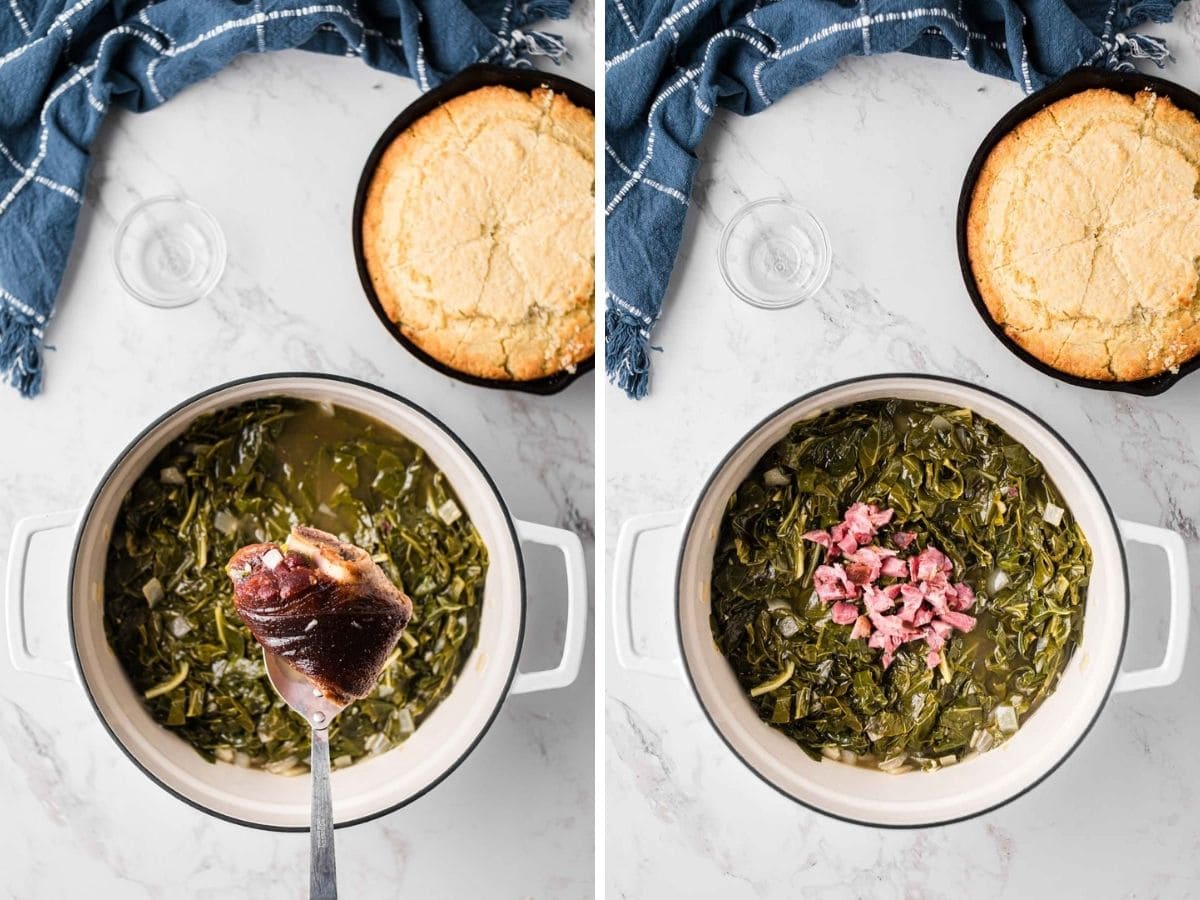
Step 7. Finish with a splash of white vinegar to brighten up the flavors!

Now, you are ready to dig in!
Want to Save this Recipe?
By submitting this form, you consent to receive emails from Soulfully Made.
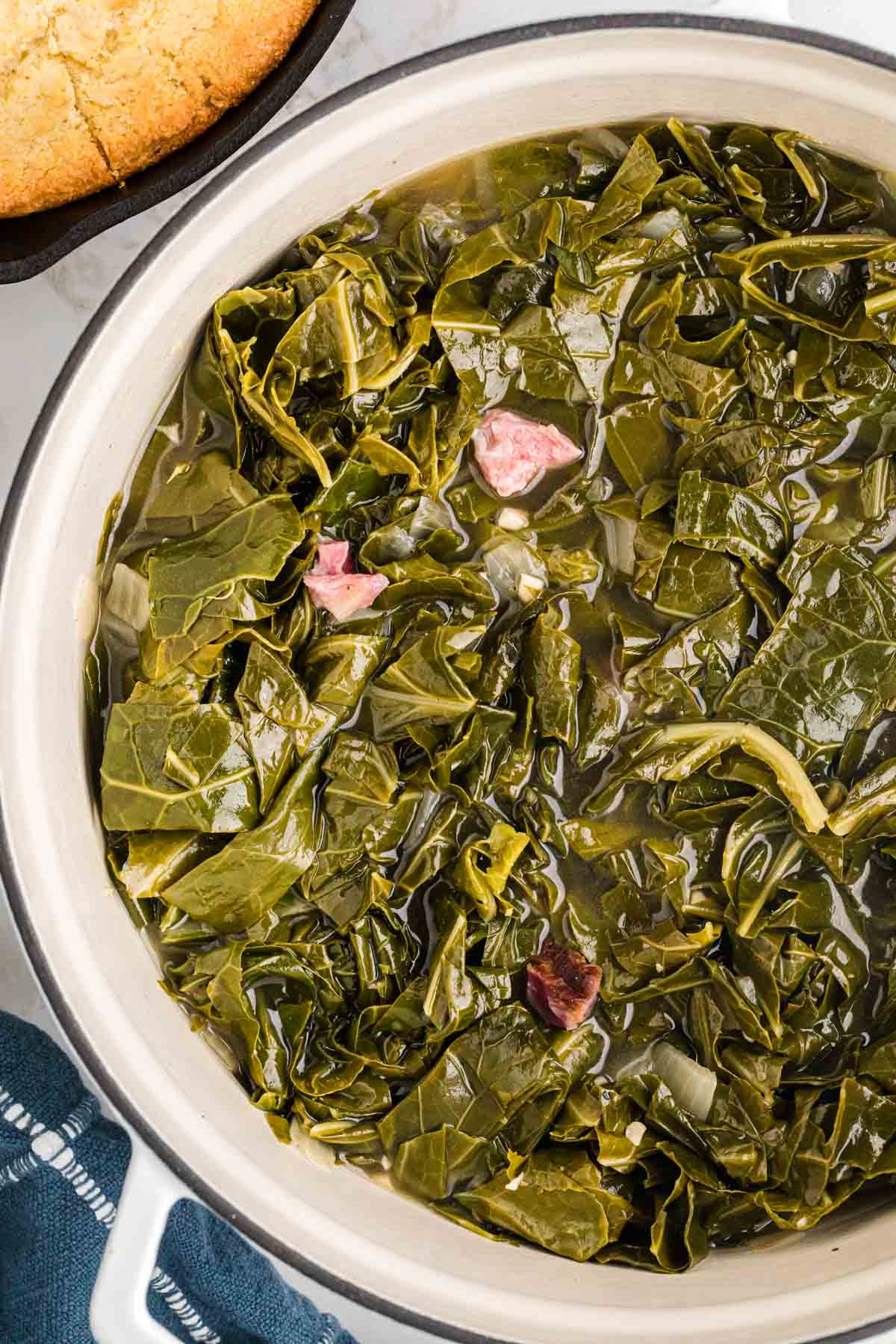
Southern Collards Recipe Tips
- Keep in mind that if you’re using sliced strips for the collard greens and a larger ham hock, it’s best to cook the ham hock in the broth for about 45 minutes to an hour before adding the collard strips. This gives the meat time to tenderize since the thinner strips of collards will cook faster than larger leaf pieces.
- Use Prepped Greens: Save time by using pre-washed and pre-cut collard greens. They’re convenient without sacrificing flavor.
- Control the Heat: Adjust red pepper flakes to your spice preference or omit them for a milder dish.
- Don’t Skimp on Broth: Start with a flavorful chicken or vegetable broth for a rich pot likker. Add more during cooking if needed to keep the greens moist and flavorful.
- Finish with Vinegar: A splash of white vinegar at the end brightens the dish and balances the richness (trust me)!
Recipe FAQs
Adding a pinch of sugar helps balance out the natural bitterness of collard greens. You can also add a splash of vinegar at the end to brighten the flavors and cut through any bitterness.
Yes, this recipe works great on other types of greens, like mustard greens or turnip greens. You can also mix collard greens with mustards or turnips for a blend of flavors and textures.
If you’re following this recipe, they really shouldn’t be bland—there are plenty of seasonings, and the pork adds a lot of flavor. But if they do taste bland, it’s likely due to under-seasoning or not using enough broth. Make sure you’re adding enough salt, pepper, garlic, and red pepper flakes, and make sure your broth is rich and flavorful to infuse the greens with depth.
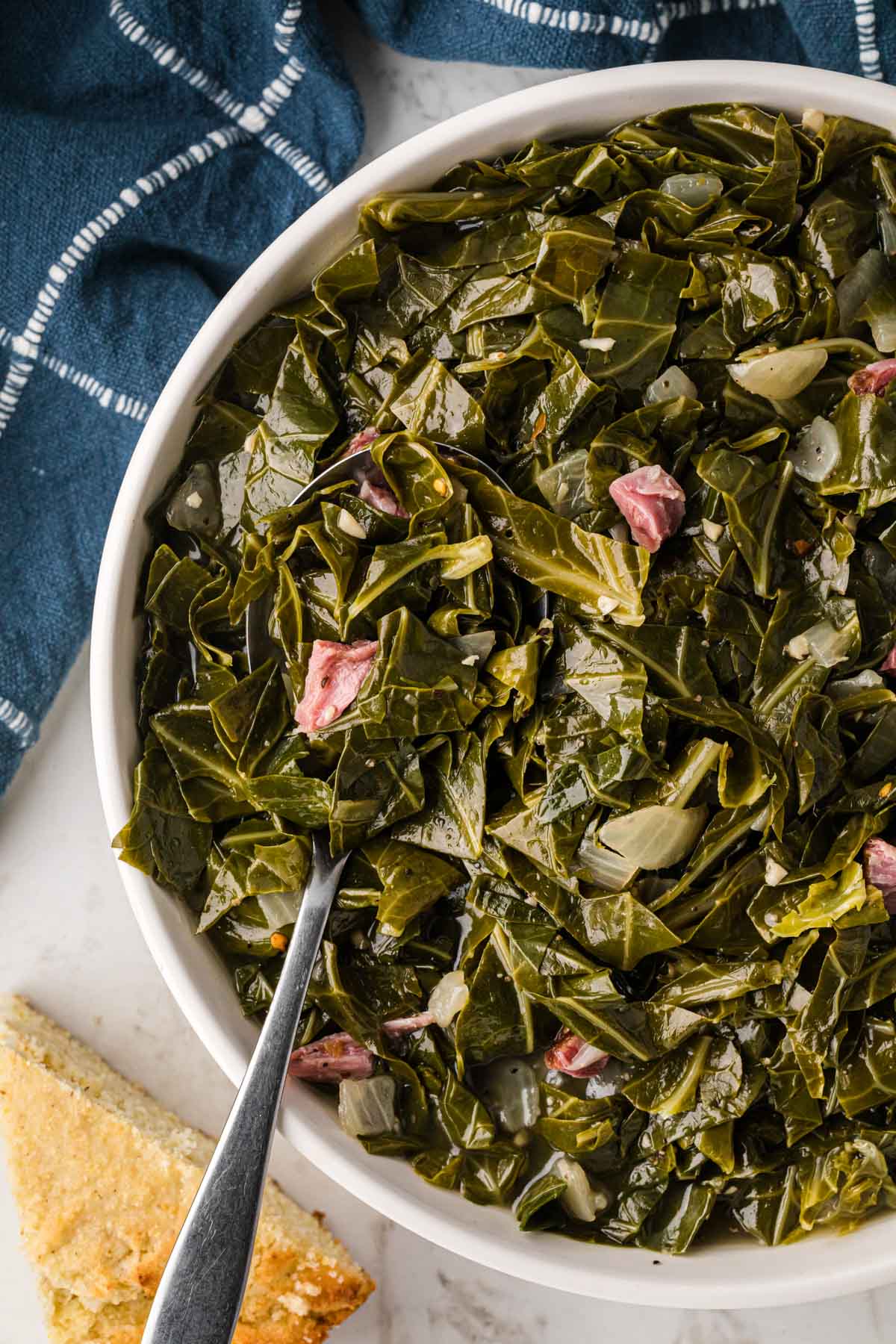
What to Serve with Collard Greens
Collard greens go perfectly with a variety of Southern dishes, making them a versatile side for any occasion. On New Year’s Day, they’re traditionally served with black-eyed peas for good luck and cornbread to symbolize prosperity.
For a hearty meal, pair them with Southern fried chicken, pork chops, or barbecue ribs. They also complement meatloaf or a slice of baked ham. And don’t forget a side of mac and cheese or mashed potatoes for a comforting, crowd-pleasing spread.
Whether you’re making collards for a New Year’s meal to bring good luck or a cozy Sunday supper, this dish is all about bringing people around the dinner table. Those moments are so precious as we reminisce over old memories and create new ones that last for generations.
Storing Southern Collard Greens
Refrigerating Fresh Greens:
Wrap unwashed collard greens loosely in a damp paper towel, then place them in a plastic or reusable produce bag. Store them in the crisper drawer, and they’ll stay fresh for 4-5 days. Wait to wash them until you’re ready to cook—too much moisture will make them wilt faster.
How to Freeze Fresh Collard Greens:
If you want to freeze fresh collards, (after cleaning and prepping) blanch them first—boil for 2-3 minutes, then transfer to an ice bath and let sit for a few minutes to stop the cooking. Drain well, pat dry (or spin them out in a salad spinner), and place them in freezer-safe bags or containers. Remove as much air as possible and then label and date them. They’ll stay good in the freezer for 3 (for best results) up to 6 months.
Storing Cooked Greens in the Fridge:
Let your cooked collards cool to room temperature before storing. Once cooled, transfer them to an airtight container. They’ll keep in the fridge for up to 4 days. To reheat, just warm them on the stovetop over low heat until heated through, or pop them in the microwave until nice and hot.
Freezing Cooked Greens:
Make sure your cooked greens have cooled to room temp before freezing. You can freeze them with the meat cooked with them and the juices. Transfer them to an airtight container or a freezer-safe bag that lays flat to save space. I like to label the bag with the date so I know how long they’ve been in there. Cooked greens will keep in the freezer for up to 3 to 6 months.
To Reheat: When you’re ready to eat them, thaw them overnight in the fridge or place them directly in a pot to cook. Warm them on the stovetop over medium-low heat, stirring often, or microwave until they’re heated all the way through. If additional liquid is needed, add a little broth to prevent scorching.

OTHER SOUTHERN DISHES YOU MAY ALSO ENJOY
- Instant Pot Beef Tips
- Baked Macaroni and Cheese
- Black-Eyed Pea and Collard Green Soup
- Baby Lima Beans
- Southern Style Green Beans
Hungry for more easy, home-cooked, delicious recipes?
Sign up for my free recipe club to get family-friendly recipes in your inbox each week! Find me sharing daily meal-time inspiration on Pinterest, Facebook, and Instagram.
Hungry for more easy, home-cooked, delicious recipes?
Sign up for my free recipe club to get family-friendly recipes in your inbox each week! Find me sharing daily meal-time inspiration on Pinterest, Facebook, and Instagram.
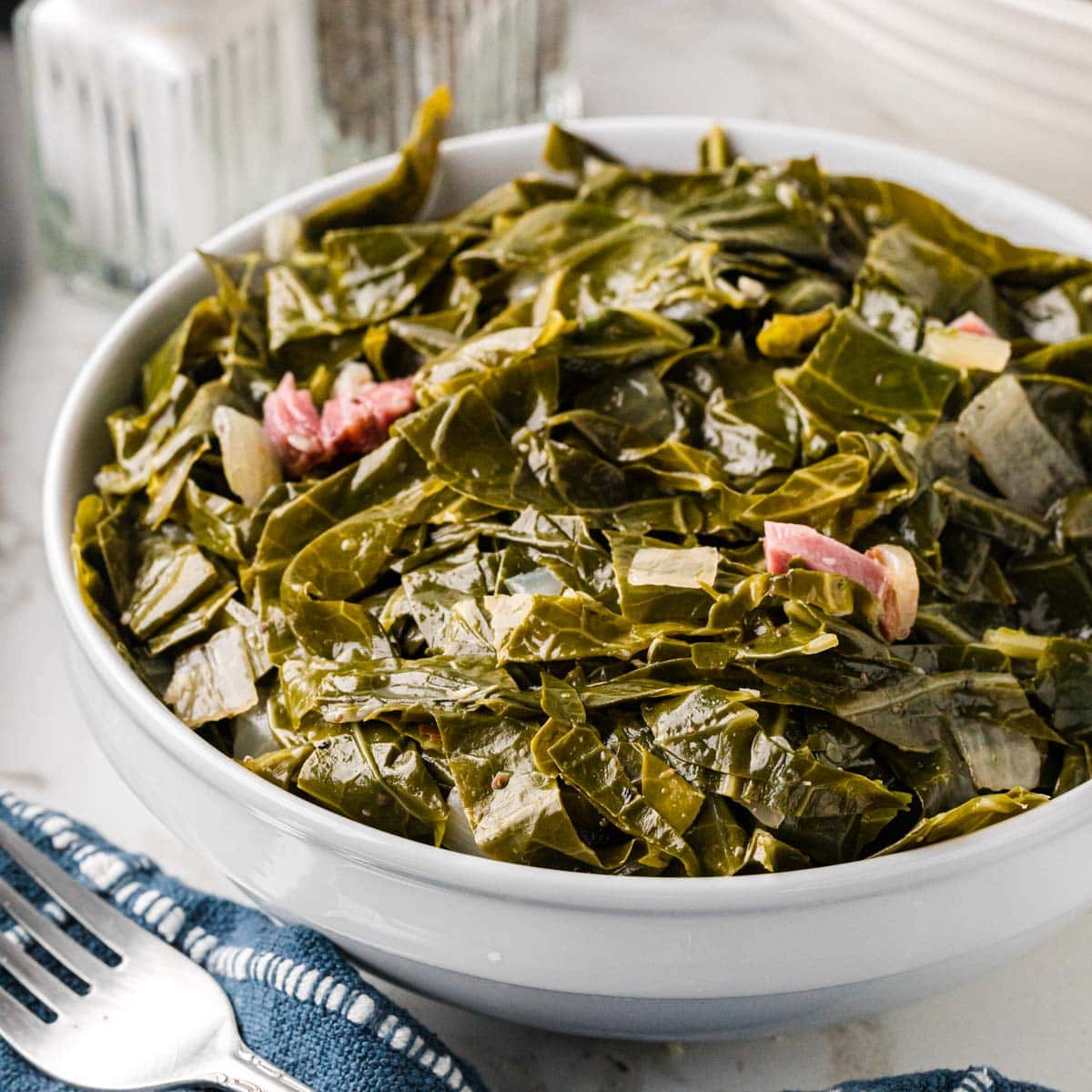
Collard Greens Southern Style
Click Stars To Rate
Ingredients
- 2 pounds collard greens - washed and chopped or torn
- ½ to 1 tablespoon avocado oil - ( or olive oil)
- ½ cup diced onion
- 4 cloves garlic - minced
- 1 to 2 teaspoons kosher salt - or to taste
- ½ to 1 teaspoon black pepper
- 1 teaspoon sugar
- ⅛ to ¼ teaspoon red pepper flakes
- 1 ham bone with meat - (ham hock or shank) can sub bacon
- 3 to 4 cups chicken stock or broth
- 1 teaspoon white vinegar - (or to taste)
Instructions
- In a dutch oven or large pot, over medium high heat, drizzle oil in the pan. Add onion and sauté for 1 to 2 minutes until translucent and fragrant. Add in garlic and sauté another minute. If you are using bacon instead of ham, cook the bacon in the pan first until desired doneness and remove the bacon. Dice the bacon into bite sized pieces if you would like the pieces scattered throughout the greens, leave whole if you would like to remove them after cooking. Then use the bacon grease to saute onion and garlic instead of using the oil.½ to 1 tablespoon avocado oil, ½ cup diced onion, 4 cloves garlic
- Add in salt, black pepper, sugar, and red pepper flakes (if using) and mix together with onions and garlic.1 to 2 teaspoons kosher salt, ½ to 1 teaspoon black pepper, 1 teaspoon sugar, ⅛ to ¼ teaspoon red pepper flakes
- Place collard greens into the pan and give it a stir.2 pounds collard greens
- Pour in chicken stock and place ham shank or desired pork into the pot and stir. Start with 3 cups and add more as the greens absorb the liquid. This will be to taste. Adjust if you like more pot liquor or potlikker (that yummy broth) in your greens.3 to 4 cups chicken stock or broth, 1 ham bone with meat
- Bring to a boil over medium high heat, reduce to simmer, cover, and cook for 1 1/2 to 2 hours (stirring occasionally) or until tender.
- Remove ham bone and shred meat into the greens if desired.
- Stir in the vinegar and serve.1 teaspoon white vinegar
Notes
Want to Save this Recipe?
By submitting this form, you consent to receive emails from Soulfully Made.


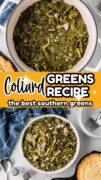





I was born and raised in Atlanta so of course I already know this recipe and it’s a great recipe I love it thank you
Thank you, fellow southern gal! I appreciate you stopping by to let us know you enjoyed them!
I made this tonight for my Southern wife. It passed her “home cooking” test and was easily the best tasting batch of New Year’s collards I’ve ever made. Thanks for making collards great again. I’ll be going back to this one!
Thank you so much, John! You made my day! If you loved these you should give my lima beans a try!
My daddy was from South Carolina, they always used fat back (salt pork) in the greens, so o it’s what I always use. Also, for alot of good southern receipes, look online for the “White Trash Cooking” series! Funny stories and great old receipes!
Fat back works as well too! I’ll have to take a look I love funny stories and old recipes! Happy New Year Leilani!
Your collard greens look amazing!
Thank you my friend! It’s time to ring in a New Year with lots of delicious dishes and hopefully a little good fortune! 🙂 Much love and many blessings to you in this New Year!